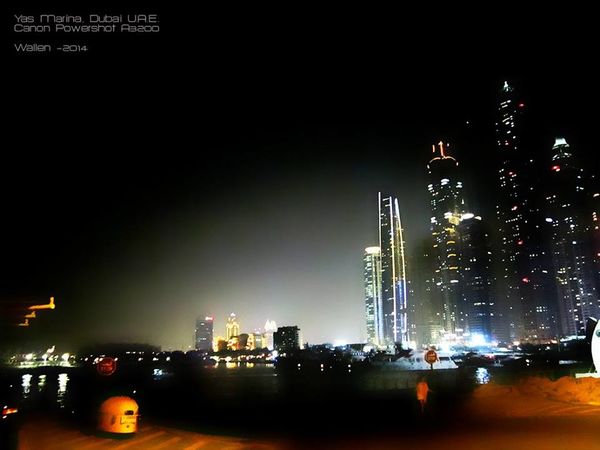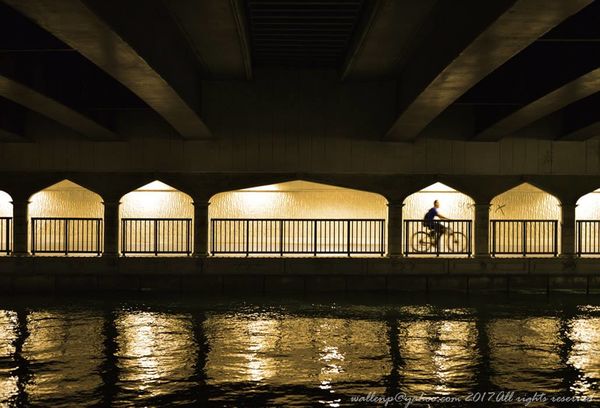Posts for: Wallen
Jan 24, 2019 05:50:22 #
If you want to take good pictures but knows next to nothing about photography then this post is for you.
Instead of formulas and computations and all that jazz, Lets break it down to a process that works most of the time. So instead of rolling dice and waiting for luck, we will be off to a logical direction and adjust/fine tune to reason as needed.
Step 1. Have something to shoot with.
For now, don't bother with what camera you have. Anything that shoot is good and we shoot this "whatever" camera until we learn what it can not do. Then that would be the time to choose your system. (*Note to future self; "System" not camera. You will know by then)
Step 2. Have something/somewhere/someone to shoot at.
Something has many other names, Somewhere is also known as landscape and someone is a portrait.
Step 3. IMAGINE & DECIDE how the photograph will look like (Composition 1).
3a. Imagine, Have a goal and aim to achieve it. IE if i want to have a picture of runner as he breaks the finish line, then prepare by visualizing what could happen and position yourself where you can capture that moment.
3b. People stand upright so in reference, we call upright composed images as portraits and Landscapes in reference to horizons, we call horizontal pictures a landscape
3c. Look with one eye- The camera see with one plane and when we close one eye and look at things, we replicate it making us imagine more clearly what the outcome will be.
Step 4. FIND A HERO and emphasize it (Composition 2).
A hero is the main focus/element of your photo. It might be a object. group of objects, a color, a person, a group of people, emotion, story ...sky is the limit. No matter what your hero is, it is imperative that it stands out and that everything else in the picture supports it. Emphasize, make it greater than life. So that when others look at the final photo, they see exactly what you envisioned.
Step 5. NO RULES (Composition 3)
You might have read or heard of certain rules like reciprocals, rule of thirds etc. The thing is, they are not rules. They are guides. They are like maps or words and just like those, a person needs to read and understand them fully to make the best out of them.
As a beginner, set them aside for the moment and follow your instinct. IF it looks good, it probably is. Because even if each persons sense of beauty is partially biased by their experiences, we all have this innate sense of looking for harmony and balance. Let those be your guide for the moment & learn the others in its own time.
Step 6. Adjust camera for the ambient light Color Cast & Intensity (WB - White balance & ISO - Sensor amplification)
As a beginner you may want to put both of these on Auto, hope for the best & proceed to step 4.
If you have something else in mind then remember first that color cast affects mood. bluish cast feels cold and lonely while reddish/warmer tones feels alive and homey.
6a. Our brain has its own white balance and automatically adjust the color we see so do not trust your eyes. The camera tells the truth.
6b. If you have manual WB in your camera, each settings produce the opposite in effect. If the ambient light is white and you adjust the WB to cloudy or shade (going to blue), the picture will become reddish. IE white minus blue=red
6c. If you adjust to incandescent lamp (going to red) and the ambient light is white, you photo will have a blue cast.
6d. So if the ambient light is cloudy and you set WB to cloudy, then the bluish ambient light will be normalized to white in the picture. IE blue minus blue=white
6e. High ISO numbers brightens the image but makes all underexposed areas dirty(Noisy)
Step 7. FOCUS IN FOCUS.
Give plenty of effort to focus correctly. What is in focus gets emphasized so it is good practice to put focus on what you intend to hero or to natural attention grabber, such as the nearest eye.
7a. How much element remains in focus is called Depth Of Field. DOF is dictated by Lens FOV, aperture size (f/stop) and your distance from the subject.
7b. Smaller f/stop number (actually bigger iris opening) and smaller distances (macro) makes small (narrow)DOF.
7c. A lens's FOV (Field of View) or the amount of space you can capture also affects DOF. Lens with wider FOV (low mm number) has a wider(deeper)DOF than those with high mm numbers (telephoto lens)
7d. Elements outside the DOF will be blurry. The amount and quality of blurriness is called BOKEH.
Step 8. DO NOT BE A JERK.
Movement unless intentional will wreck a picture with motion blur and streaks so learn to be a smooth operator.
8a. Support the camera properly and Refrain from jerking the trigger.
8b. Use a proper tripod and remote trigger if needed.
8c. Fast shutter speed will freeze moving objects but also make the image darker so Use the lowest shutter speed you can get away with.
8d. Slow shutter speed can be used intentionally to creates fancy movement blurs, invisibility or softness.
8e. Give the everything in view a quick scan including the exposure meter and if everything looks ok, then click away.
Step 9. CHIMP
Let us recap;
Have camera & Subject OK
Composition OK
White balance & ISO OK
Focus point OK
Aperture/DOF OK
Shutter speed/Motion blur OK
Smooth clicks OK
CHIMP - Check Cast, Histogram, I (eye - some may have their eyes closed, re do the picture) & Manipulate the Process. You may need to adjust the subject themselves, not only your camera settings.
As you get better, you will chimp less and less.
Step 10. ADJUST
Chimping allows us to see if we did right. As a beginner, this is one of your best tool. Hopefully your problem by now is only about exposure. If then, the exposure compensation button, is our first goto adjustment. Shutter speed & Aperture will be adjusted depending on our need for Motion Blur or DOF.
Since we have chosen our aperture and shutter speed deliberately, we will then adjust ISO to compensate for over or under exposure. If Adjusting ISO is not enough, then keep ISO up and adjust Aperture to allow more light. If not enough the we lessen shutter speed for more light. We set Shutter speed first on our first shoot and adjust it as our last resort.
Step 11. SHOOT UNTIL RAW
Shoot again and again. Do not be a sniper unless that is all that can be done. Change composition, DOF, Exposure etc. Make good adjustments and keep shooting. Shoot a variety of situations and subjects. Each one has their own challenges. From JPG, shoot and learn until you know and become comfortable with RAW. By this time, you will know enough of your tools that you can decide your for your system.
Step 12. ANALYZE EDIT SHOW
Study your images and see how it can be improved. Study other photographers images. Swap stories, Print your favorites etc. Learn editing soft-wares but most of all, keep the fire burning.
Photography is not a burger that can be downed in a single bite. It is a more like a pizza, whose little slices need to be nibbled and enjoyed. It is about seeing thing in another light and capturing that so others may see it too.
Instead of formulas and computations and all that jazz, Lets break it down to a process that works most of the time. So instead of rolling dice and waiting for luck, we will be off to a logical direction and adjust/fine tune to reason as needed.
Step 1. Have something to shoot with.
For now, don't bother with what camera you have. Anything that shoot is good and we shoot this "whatever" camera until we learn what it can not do. Then that would be the time to choose your system. (*Note to future self; "System" not camera. You will know by then)
Step 2. Have something/somewhere/someone to shoot at.
Something has many other names, Somewhere is also known as landscape and someone is a portrait.
Step 3. IMAGINE & DECIDE how the photograph will look like (Composition 1).
3a. Imagine, Have a goal and aim to achieve it. IE if i want to have a picture of runner as he breaks the finish line, then prepare by visualizing what could happen and position yourself where you can capture that moment.
3b. People stand upright so in reference, we call upright composed images as portraits and Landscapes in reference to horizons, we call horizontal pictures a landscape
3c. Look with one eye- The camera see with one plane and when we close one eye and look at things, we replicate it making us imagine more clearly what the outcome will be.
Step 4. FIND A HERO and emphasize it (Composition 2).
A hero is the main focus/element of your photo. It might be a object. group of objects, a color, a person, a group of people, emotion, story ...sky is the limit. No matter what your hero is, it is imperative that it stands out and that everything else in the picture supports it. Emphasize, make it greater than life. So that when others look at the final photo, they see exactly what you envisioned.
Step 5. NO RULES (Composition 3)
You might have read or heard of certain rules like reciprocals, rule of thirds etc. The thing is, they are not rules. They are guides. They are like maps or words and just like those, a person needs to read and understand them fully to make the best out of them.
As a beginner, set them aside for the moment and follow your instinct. IF it looks good, it probably is. Because even if each persons sense of beauty is partially biased by their experiences, we all have this innate sense of looking for harmony and balance. Let those be your guide for the moment & learn the others in its own time.
Step 6. Adjust camera for the ambient light Color Cast & Intensity (WB - White balance & ISO - Sensor amplification)
As a beginner you may want to put both of these on Auto, hope for the best & proceed to step 4.
If you have something else in mind then remember first that color cast affects mood. bluish cast feels cold and lonely while reddish/warmer tones feels alive and homey.
6a. Our brain has its own white balance and automatically adjust the color we see so do not trust your eyes. The camera tells the truth.
6b. If you have manual WB in your camera, each settings produce the opposite in effect. If the ambient light is white and you adjust the WB to cloudy or shade (going to blue), the picture will become reddish. IE white minus blue=red
6c. If you adjust to incandescent lamp (going to red) and the ambient light is white, you photo will have a blue cast.
6d. So if the ambient light is cloudy and you set WB to cloudy, then the bluish ambient light will be normalized to white in the picture. IE blue minus blue=white
6e. High ISO numbers brightens the image but makes all underexposed areas dirty(Noisy)
Step 7. FOCUS IN FOCUS.
Give plenty of effort to focus correctly. What is in focus gets emphasized so it is good practice to put focus on what you intend to hero or to natural attention grabber, such as the nearest eye.
7a. How much element remains in focus is called Depth Of Field. DOF is dictated by Lens FOV, aperture size (f/stop) and your distance from the subject.
7b. Smaller f/stop number (actually bigger iris opening) and smaller distances (macro) makes small (narrow)DOF.
7c. A lens's FOV (Field of View) or the amount of space you can capture also affects DOF. Lens with wider FOV (low mm number) has a wider(deeper)DOF than those with high mm numbers (telephoto lens)
7d. Elements outside the DOF will be blurry. The amount and quality of blurriness is called BOKEH.
Step 8. DO NOT BE A JERK.
Movement unless intentional will wreck a picture with motion blur and streaks so learn to be a smooth operator.
8a. Support the camera properly and Refrain from jerking the trigger.
8b. Use a proper tripod and remote trigger if needed.
8c. Fast shutter speed will freeze moving objects but also make the image darker so Use the lowest shutter speed you can get away with.
8d. Slow shutter speed can be used intentionally to creates fancy movement blurs, invisibility or softness.
8e. Give the everything in view a quick scan including the exposure meter and if everything looks ok, then click away.
Step 9. CHIMP
Let us recap;
Have camera & Subject OK
Composition OK
White balance & ISO OK
Focus point OK
Aperture/DOF OK
Shutter speed/Motion blur OK
Smooth clicks OK
CHIMP - Check Cast, Histogram, I (eye - some may have their eyes closed, re do the picture) & Manipulate the Process. You may need to adjust the subject themselves, not only your camera settings.
As you get better, you will chimp less and less.
Step 10. ADJUST
Chimping allows us to see if we did right. As a beginner, this is one of your best tool. Hopefully your problem by now is only about exposure. If then, the exposure compensation button, is our first goto adjustment. Shutter speed & Aperture will be adjusted depending on our need for Motion Blur or DOF.
Since we have chosen our aperture and shutter speed deliberately, we will then adjust ISO to compensate for over or under exposure. If Adjusting ISO is not enough, then keep ISO up and adjust Aperture to allow more light. If not enough the we lessen shutter speed for more light. We set Shutter speed first on our first shoot and adjust it as our last resort.
Step 11. SHOOT UNTIL RAW
Shoot again and again. Do not be a sniper unless that is all that can be done. Change composition, DOF, Exposure etc. Make good adjustments and keep shooting. Shoot a variety of situations and subjects. Each one has their own challenges. From JPG, shoot and learn until you know and become comfortable with RAW. By this time, you will know enough of your tools that you can decide your for your system.
Step 12. ANALYZE EDIT SHOW
Study your images and see how it can be improved. Study other photographers images. Swap stories, Print your favorites etc. Learn editing soft-wares but most of all, keep the fire burning.
Photography is not a burger that can be downed in a single bite. It is a more like a pizza, whose little slices need to be nibbled and enjoyed. It is about seeing thing in another light and capturing that so others may see it too.
Jan 22, 2019 05:08:03 #
Photogirl17 wrote:
Very nice set Wallen..Pg. 17
Thank you
Jan 22, 2019 01:46:41 #
rook2c4 wrote:
Did you consider the possibility that the lens wou... (show quote)
If we analyze the problem as ballistics, any material that our moving object encounters specially when it breaks, takes energy away from the projectile and lessen impact velocity/penetration. Bulletproof glass are many layers of thin glass glued together. As each sheet breaks, it slows the bullet to the point it stops and the last sheets are not damaged.
UV filters will help with dirt and impacts. How much will depend on the circumstance. On the other hand, how much it affects the image will highly depend on the quality of the filter. A good quality UV filter should be negligible.
Jan 22, 2019 01:09:00 #
Transbuff1985 wrote:
Nice shots. thanks for sharing. Bob pg24
Thank you
Jan 22, 2019 00:58:31 #
Rolk wrote:
Pg. 17 - Great creativity on this series, Wallen! Nicely done.
Tim
Tim
Thanks a lot.
They each have their own challenges;
1.The moored boats were all bobbing up and down every time another boat passes by and it took i while to get a sharp image with a long exposure.
2.The Marina -camera was a point and shoot.
3. Cyclist under the bridge was the hardest to capture. no tripod, no flash, mixed light source, too much light contrast, capture movement in low light and no control of the subject (passersby). It was luck and technique in equal amounts.
Here are some more. Sunset under a bridge; Taken last December with a Huawei celphone, edited with PS


Jan 22, 2019 00:01:09 #
Transbuff1985 wrote:
Nice set Wallen thanks for sharing. Bob pg17
Thanks
Jan 21, 2019 23:58:42 #
PAToGraphy wrote:
p.17 The lighting and composition of the last one is wonderful - the lines jnterrupted by soft arcs and bicycle wheels. Just love it.
Thanks.
It is one of my favorites as well because of how technical (and lucky with the passing cyclist) it was to get it right.
Jan 21, 2019 22:08:12 #
Some old low lights from D5300 a Canon point and shoot and a D7100.



Jan 15, 2019 23:49:35 #
Bipod wrote:
Are there any artists or scientists on UHH? Very, very few posts.
Are there any artists or scientists on UHH? Very, very few posts.
:-) I claim to be both- a scientist and an artist and many things else LOL.
Bipod wrote:
Let's all change the world! But let's make sure the change is an improvment.
Let's all change the world! But let's make sure the change is an improvment.
Been trying, but it seems the world does not really want peace.
I propose the CODE (Communal Democracy) as a universal form of government, Iscariot as a way of life and Self rule without harm as the soul & core of existence.
Anybody interested please contact me for details :-)
Bipod wrote:
No single person every changed the world more than Adolf Hitler (who was,
incidentally an artist, a vegan and a believer in astrology--very "New Age").
No single person every changed the world more than Adolf Hitler (who was,
incidentally an artist, a vegan and a believer in astrology--very "New Age").
Hmmm, i believe that would be Jesus, because even Adolf's moves was connected with the guy.
But if Adam and Eve was real, the person we should blame for all the problems in the world is a woman :-)
Bipod wrote:
It's easy to accept the beliefs of one's time, whether its slavery, anti-semitism or
technologism. (Have you ever noticed that the solution to any technological problem
is....more technology? If the product killed you, you need to buy the upgrade.)
It's easy to accept the beliefs of one's time, whether its slavery, anti-semitism or
technologism. (Have you ever noticed that the solution to any technological problem
is....more technology? If the product killed you, you need to buy the upgrade.)
Not for me it though. I'm pretty much an oddball when it come to beliefs and point of views. I tend to see things as spheres instead of coins.
Bipod wrote:
People forget that there are two kinds of innovation: good and bad. Examples of
the former category include aspirin and indoor plumbing,. Examples of the latter:
cigarettes, thalidomide, asbestos and novochok.
People forget that there are two kinds of innovation: good and bad. Examples of
the former category include aspirin and indoor plumbing,. Examples of the latter:
cigarettes, thalidomide, asbestos and novochok.
My take is that generally, good or bad is just a preferential point of view. Innovation is always a step up but people tend to view or fooled to view commercialism as innovation.
Bipod wrote:
The conquest of photography by consumerism has almost gone
unnoticed. But not by art historians. And not by future generations--history is
a harsh critic.
The conquest of photography by consumerism has almost gone
unnoticed. But not by art historians. And not by future generations--history is
a harsh critic.
You have me confused here. Consumerism is the protection or promotion of the interests of consumers.
Jan 15, 2019 22:39:12 #
Picture Taker wrote:
Are we confusing "ART" with taste. That is another subject
That is the truth. Very few understand what art is but everybody is a critique/opinionated.
Even some of those who trained are more concerned with their own taste than what art really is. Such as calling a light-bulb that goes on and off in an empty room or a peeing statue art. Worse, they believe and push it as high art and is the future of artistic endeavors.
Jan 15, 2019 22:14:25 #
Shutterbug57 wrote:
You must be a young one. Most of us older folk would remember sitting through interminable slide shows from our neighbors vacations. There was another way to show pictures that did not include printing.
Yes, and we have been adept at reading negatives too, choosing which ones to print from there :-)
Jan 14, 2019 23:35:51 #
kymarto wrote:
Indeed. Since you can't print a RAW, or even view it for that matter, what are you using to convert and view the RAW vs the jpg?
I use Photoshop to go straight to editing because i have little free time and edit only photos i find interesting. I revert to the native brands software if its not possible to open the files directly with PS.
This fit me because I shoot RAW only if i'm getting paid.
For my own use, i have allocated one button on my camera to shoot Jpeg+RAW so i have an instant option if i want to because generally, i shoot with my own picture control settings directly to Jpeg.
Jan 14, 2019 00:40:21 #
srt101fan wrote:
Larry - I find this comment of yours bothersome: ... (show quote)
:-) RAW is how the camera saw the image and saved it. But we can not see raw files. we need to interpret those files to something in the monitor for us to see. That process of interpretation is what some judge as "manipulation". The difference is, that interpretation is subjective and only temporary. Done for the sole purpose of enabling us to view the digital data.
Different soft wares and settings can change how that interpretation will appear even without our intent or control.
On the other hand, JPG or other file images are the saved interpretations. Many of the data still available in the RAW file would be lost when we save the interpreted images. That is why these file sizes are smaller in comparison.
Thus it is indeed true that the raw files are unchanged and not affected by settings, it is also true that whatever you see is affected as it is already an interpreted data.
On the other hand, intentional editing and modification is the crux of manipulation and is totally another matter.
:-)
Jan 14, 2019 00:11:04 #
G Brown wrote:
I am sure that Artists scream 'Rubbish' at art work they dislike, just as photographers do.
Sure they do LOL. The truth is that a lot of people think themselves are artist but in reality, they are just b*llsh*tting to benefit themselves.
G Brown wrote:
With only a little bit of knowledge you can make out you are a qualified critic.
Even with no knowledge, everyone has opinions.
HOW things are made isn't really relevant....self made critics abound everywhere.
Have fun doing what you do - who knows... 50 years after your death what you produce now might well become the latest trendy work of Art..
Even with no knowledge, everyone has opinions.
HOW things are made isn't really relevant....self made critics abound everywhere.
Have fun doing what you do - who knows... 50 years after your death what you produce now might well become the latest trendy work of Art..
Critique is one of those where little knowledge becomes really dangerous, most specially when spoken by prominent figures of society.
Jan 13, 2019 23:35:45 #
Jupiter Creek wrote:
Just to modify my explanation.
The spider is in perfect focus in RAW, it isn't in the jpeg
The spider is in perfect focus in RAW, it isn't in the jpeg
Actually my comment was a general overview. Specifics will happen only if i know exactly what you are doing and what software you are using. Perhaps you can give a little more detail?